Driving in France (and Post Traumatic Stress Disorder)
Written by: Graham Gilbert Date: 4 April 2013
French motorists and Gallic driving techniques have had their detractors over the years but I for one am happy to leap to the defence of the French driver.
I can state quite categorically that it is perfectly safe to drive at any time on French roads – on the 18th of April ‘La Journée de la Courtoisie au Volant’ (the Day of Courtesy at the Wheel).
Providing you carefully arrange for your annual holidays to coincide with this 24 hour period and you hotfoot it back before the 19th you have absolutely nothing to fear.
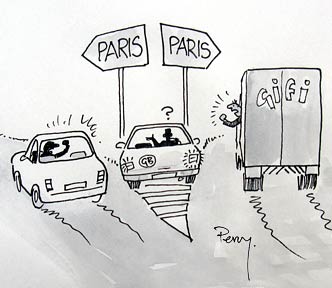 © All drawings copyright Perry Taylor 2013
© All drawings copyright Perry Taylor 2013I speak as one who is still traumatised from my first encounter with just French road signs. On my first incursion I was driving merrily along the motorway from Calais when I was suddenly confronted with a sign which seemingly invited me to go two ways at once. Finding myself in the impossibility of complying I had no option but to stop in front of the sign and ponder its meaning. To the accompaniment of blazing horns and flashing lights it slowly dawned on me that I was straddling the motorway exit and in imminent danger of sparking an international incident. With as much discretion as I could muster amid such a cacophony I sheepishly rejoined the main carriageway.
Once off the motorway I made the acquaintance of another sign which I could only assume had been left over from the days when their principal purpose was to spread complete confusion among any invading Panzer division.
Whereas on British roads any doubt as to which direction to take at a forthcoming junction is dispelled by a large pictorial representation of the upcoming road layout; here, on arriving at a critical intersection, I was greeted with a pole at the side of the road – with the various destinations marked on arrows which physically pointed towards the road to take. Now, as you approach such a sign you obviously wouldn’t be able to read an arrow which pointed straight on, so – and this is the clever bit – they make it point to the left so you can read it.
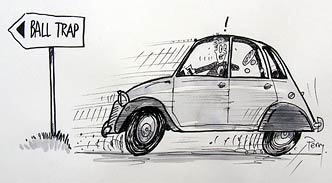 © All drawings copyright Perry Taylor 2013
© All drawings copyright Perry Taylor 2013By the time I realised what was going on I was in danger of featuring in the more up-to-date guidebooks of the area and the initial bonhomie and cheery banter I enjoyed with the well disposed locals was becoming more stretched with each orbit.
Finally breaking free and finding myself in the countryside I hoped that my state of agitation would be calmed somewhat - instead of which I was greeted with a road sign which induced total panic. ‘Ball Trap’ it announced. I put my foot down somewhere through the floor panel and didn’t let up until I was back in relative civilization. Later, upon enquiring into the rules of this most peculiar activity, I discovered that it was in fact clay pigeon shooting. I could now uncross my legs.
The already fraught process of communication between British and French drivers is further exacerbated by the fact that the very same gesture can have exactly the opposite meaning. In England you concede the right of way by flashing your lights and your grateful fellow road user (when he doesn’t insist on your going first) thanks you by presenting an open palm or flashing his lights ; you acknowledge the ‘thank you’ by mirroring this gesture in the motoring equivalent of ‘you’re welcome’ – thereby concluding the ritual.
Now in France there’s none of this nonsense, you just NEVER give way – not even when your adversary actually HAS the right of way. In France if you invite a fellow road user to go before you, you will be viewed as completely stupid or as having some fiendishly clever ulterior motive, for example there is a nearby cliff he hasn’t seen.
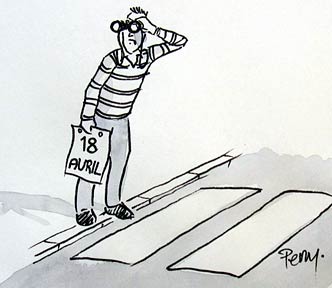 © All drawings copyright Perry Taylor 2013
© All drawings copyright Perry Taylor 2013If ever a French motorist flashes his lights at you NEVER think he is inviting you to go before he does, this means “Look out Inglishe, ear a come”.
Only in France do motorists approaching a roundabout have to be reminded that they do not have right of way – this is because until relatively recently they did! The law was changed overnight – making for an even more stimulating start to the day than usual for a critical period when absolutely everyone thought they had right of way. Now, ‘Vous n’avez pas la priorité’ signs remind drivers that even France will no longer allow motorists to career recklessly onto roundabouts causing carnage and oblivion to fellow road users.
No, to do that they have to have ‘Priorité a droite’ – a homicidal anachronism which allows a motorist joining the carriageway from any road on the right without a Stop sign to hurtle into your path like a heat-seeking missile WITH THE FULL SUPPORT OF THE LAW.
It’s just my opinion but driving through towns with one’s head permanently locked to the right seems unlikely to play a major contribution to road safety.
So how can the same Frenchman who walks into the boulangerie and greets everyone in the shop with his customary “Bonjour Messieurs Dames”, and who wouldn’t dream of walking between you and something you’re looking at without a courteous “Pardon” be transformed into such a homicidal maniac behind the wheel?
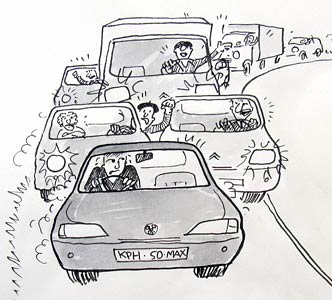 © All drawings copyright Perry Taylor 2013
© All drawings copyright Perry Taylor 2013I gained an insight into this when being driven by a very placid French friend as she approached an infamously dangerous intersection and suddenly floored the accelerator.
“It eez très dangeroose ‘ear mon ami, we musts not to ‘ang about,” she said insisting that it was best to “appuyer sur le champignon” (press on the mushroom). I was quite impressed with this gastronomic metaphor in the presence of almost certain death.
There is also that nonchalant indifference to the internationally recognised procedure of ‘mirror, signal, manoeuvre’, which for economy of effort has been abbreviated to just ‘manoeuvre’ – or further south ‘manoeuvre, blast your horn, give bras d’honneur’ (the French equivalent of the ‘V’ sign) – this while overtaking on a blind bend on a vertiginous mountain pass.
I recall the occasion of my two-month long Grand Tour of France in 2005 when I started French Property Centre – a journey undertaken in an Astra which, due to cylinder head gasket problems, was incapable of reaching 50 mph. Hundreds of French car and lorry drivers tried (and unfortunately failed) to make me speed up by tailgating me, flashing their lights and sounding their horns in fury – this when they could easily have overtaken and when I had my hazard warning lights on!
It has to be noted that on the home run between Dover and Walsall (where my faithful steed breathed her last) not one English driver behaved in this manner.
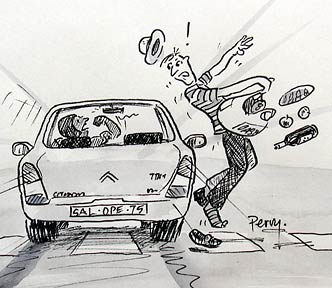 © All drawings copyright Perry Taylor 2013
© All drawings copyright Perry Taylor 2013I must admit that being English the thought that I might dictate the speed at which someone else drives hadn’t occurred to me before. But being an ardent Francophile I thought I’d better throw myself into the spirit of things and for every flash of lights or perp of a horn I braked and went even slower – sometimes down to an almost complete standstill.
I think my fellow road users really began to appreciate the effort I was making to ‘speak the language’ because when finally they would overtake they seemed to be having a party or even a disco onboard as there were lights flashing, horns blazing and arms – and sometimes even legs – projecting out of windows as though to wish me well on my way.
Many were so pleased with my driving they even suggested I go backwards. “Enculé,” they insisted.
There’s only one place more dangerous than being in a car in France and that’s being on a pedestrian crossing. While actually killing a pedestrian on a crossing is no longer as popular as it once was, a spot of light maiming with the wing mirror enjoys the same support as say ‘I spy’ or other onboard activities devised to keep the children amused.
Of course French pedestrians know this and cunningly wait until no cars are visible before crossing – which rather defeats the object.
To the British a pedestrian crossing is a cornerstone of civilisation, an inviolable space that enshrines our concern for the safety of the elderly, the disabled and young children. To the French it is a conveniently located extra parking space particularly useful for that emergency visit to the Patisserie.
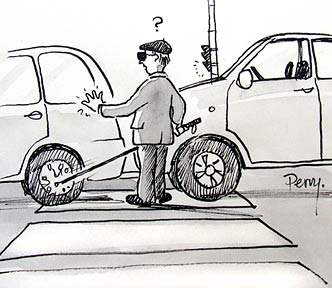 © All drawings copyright Perry Taylor 2013
© All drawings copyright Perry Taylor 2013I can still recall the look on a motorist’s face when I was forced to complete my crossing clambering through the back seat of his car.
The difference between our two great nations was never more clearly illustrated than on my return to England after a long sojourn in France. I was standing in the very heart of the City of London at rush hour - and at least a yard away from a crossing - when, in a scene reminiscent of the parting of the Red Sea, this great city’s heart stopped and invited me to cross.
Until that moment I hadn’t even seen the crossing but faced with such a courteous invitation there was only one thing an Englishman could do – I dutifully crossed and waited until my well-wishers were out of sight before crossing back.
The whole scene would have been unthinkable in France – where my experiences had forced me to conclude that the majority of French motorists had actually found their driving licences in a ‘lucky bag’.
So I suppose even a single day of courtesy behind the wheel in France is a step in the right direction.
Quite frankly the safest time to drive in France is between 12 and 2 when every French motorist and policeman is genetically incapable of being anywhere else but in a restaurant, thereby leaving the roads free for us Brits to drive without let or hindrance where God intended us to – on the left.
We'd love to hear from you!
Search by Region or Department
Why Sign Up?
- Save your search criteria
- Recommended properties
- Ideal Property Email Alerts
- Save & Print favourites
- Ask property questions
 Graham Gilbert is the Managing Director of
Graham Gilbert is the Managing Director of